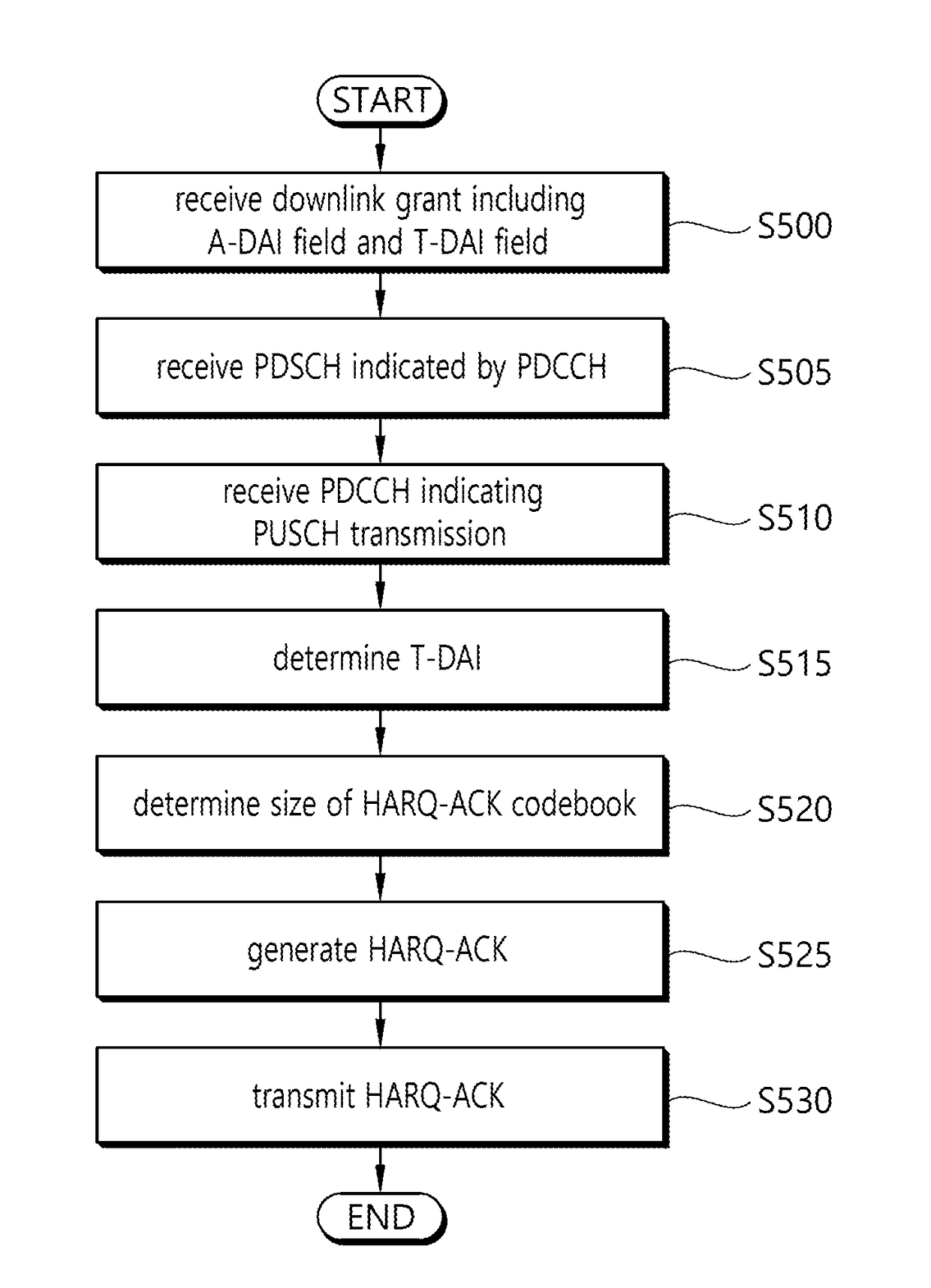Apparatus and method for performing hybrid automatic repeat request operation in wireless communication system supporting carrier aggregation
- Summary
- Abstract
- Description
- Claims
- Application Information
AI Technical Summary
Benefits of technology
Problems solved by technology
Method used
Image
Examples
first embodiment
Determining the Size of a HARQ-ACK Codebook Based on a T-DAI that is Actually Allocated to a UE
[0066]According to the present embodiment, a UE determines a T-DAI that is actually allocated to the UE based on an A-DAI field and a T-DAI field.
[0067]Here, the value of a single T-DAI field may correspond to a plurality of T-DAIs (that is, a T-DAI set). In other words, a plurality of T-DAIs may be indicated by a single T-DAI field value. For example, when a T-DAI field is 2 bits as shown in following Table 2, the T-DAI field has four values XDAItotal, that is, 00, 01, 10, and 11, and a single value may be mapped to a plurality of T-DAIS.
TABLE 2T-DAI field (MSB,T-DAI LSB)XDAItotalset corresponding to T-DAI field0, 011, 5, 9, 13, 17, 21, 25, 290, 122, 6, 10, 14, 18, 22, 26, 301, 033, 7, 11, 15, 19, 23, 27, 311, 140, 4, 8, 12, 16, 20, 24, 28, 32
[0068]Referring to Table 2, when XDAItotal, a T-DAI that is actually allocated to a UE may be one of the values in the set {1, 5, 9, 13, 17, 21, 25,...
second embodiment
Determining the Size of a HARQ-ACK Codebook Based on the Value of a Received T-DAI Field
[0078]The present embodiment is a method of determining the size of a HARQ-ACK codebook assuming a situation in which an FDD PUCCH cell group is applied. When a PUSCH transmission is performed based on a received (E)PDCCH (DCI format 0 or 4), a UE determines the size of a HARQ-ACK codebook based on the value of a T-DAI field, and performs a HARQ-ACK transmission. To this end, the UE according to the present embodiment may calculate the total number of scheduled serving cells (or CCs).
[0079]An example of a method of calculating the total number of scheduled serving cells (or CCs) is as shown in Equation 1 provided below.
BDL=XDAItotal+┌(D−XDAItotal) / 2k┐·2k [Equation 1]
[0080]Referring to Equation 1, BDL indicates the number of CWs or the number of serving cells that require HARQ-ACK reporting out of the total serving cells. For example, when a PUSCH is transmitted in subframe n, BDL indicates the n...
third embodiment
[0103]When a PUSCH transmission is indicated by an (E)PDCCH (DCI format 0 / 4), a UE may determine the size of an entire HARQ-ACK codebook based on methods of Option 1 to 4, and may perform a HARQ-ACK transmission.
[0104]For example, according to Option 1, a UL T-DAI field is included in an uplink grant. Therefore, a UE calculates the size of a HARQ-ACK codebook on a PUSCH based on a UL T-DAI field. In this instance, the UE may derive a T-DAI that is actually allocated to the UE based on the UL T-DAI field. The method that is the same as in Case 1 may be used. Here, when the size of a HARQ-ACK codebook calculated based on a DL T-DAI and the size of a HARQ-ACK codebook calculated based on a UL T-DAI are different from each other, the UE determines this as an erroneous situation, and determines the size of a HARQ-ACK codebook based on one that is most recently received out of the DL T-DAI and the UL T-DAI. Alternatively, when the DL T-DAI and the UL T-DAI are received in the same subfram...
PUM
 Login to View More
Login to View More Abstract
Description
Claims
Application Information
 Login to View More
Login to View More - R&D
- Intellectual Property
- Life Sciences
- Materials
- Tech Scout
- Unparalleled Data Quality
- Higher Quality Content
- 60% Fewer Hallucinations
Browse by: Latest US Patents, China's latest patents, Technical Efficacy Thesaurus, Application Domain, Technology Topic, Popular Technical Reports.
© 2025 PatSnap. All rights reserved.Legal|Privacy policy|Modern Slavery Act Transparency Statement|Sitemap|About US| Contact US: help@patsnap.com



